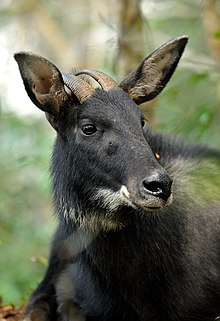
Pursat is a province of Cambodia. It is in the western part of the country and borders clockwise from the north: Battambang province, the Tonlé Sap, Kampong Chhnang province, Kampong Speu province, Koh Kong province, and East Thailand. It lies between the Tonle Sap and the northern end of the Cardamom Mountains. The Pursat River bisects the province, running from the Cardamoms in the west to the Tonle Sap in the east.

The Cardamom Mountains, or the Krâvanh Mountains, is a mountain range in the southwest part of Cambodia and Eastern Thailand. The majority of the range is within Cambodia.
Cambodians in France consist of ethnic Khmer people who were born in or immigrated to France. The population as of 2020 was estimated to be about 80,000 making the community one of the largest in the Cambodian diaspora. The Cambodian population in France is the most established outside Southeast Asia, with a presence dating to well before the Vietnam War and subsequent Indochina refugee crisis including the horrors of Pol Pot and the Khmer Rouge who took over in Phnom Penh on 17 April 1975. A few numbers of Cambodian people were able to escape and migrate to France before the Khmer Rouge took power in Cambodia as the Cambodian Civil War came to an end and overthrow U.S.-backed military dictatorship of Lon Nol and the Khmer Republic. His brother Lon Non and the other Khmer officials were arrested and executed by the CPK, the Marxist-Leninist dictatorship that seized power in Phnom Penh. 13 days before the Fall of Saigon and the Second Indochina War ended on 30 April 1975.

The National Museum of Cambodia is Cambodia's largest museum of cultural history and is the country's leading historical and archaeological museum. It is located in Chey Chumneas, Phnom Penh.
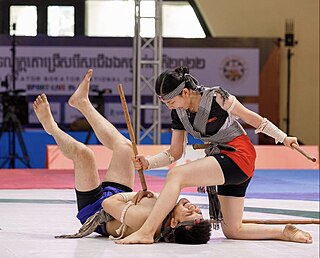
Bokator or Kun L'bokator is an ancient Cambodian battlefield martial art. It is one of the oldest fighting systems existing in the world and is recognised as intangible cultural heritage by the UNESCO.

The wildlife of Cambodia is very diverse with at least 162 mammal species, 600 bird species, 176 reptile species, 900 freshwater fish species, 670 invertebrate species, and more than 3000 plant species. A single protected area, Keo Seima Wildlife Sanctuary, is known to support more than 950 total species, including 75 species that are listed as globally threatened on the IUCN Red List. An unknown amount of species remains to be described by science, especially the insect group of butterflies and moths, collectively known as lepidopterans.
Krakor is a district in Pursat province, Cambodia. The district capital is Krakor town located 25 kilometres east of the provincial capital, Pursat town.

Wildlife Alliance is an international non-profit forest and wildlife conservation organization with current programs in Cambodia. It is headquartered in New York City, with offices in Phnom Penh. The logo of the organization is the Asian elephant, an emblematic species and the namesake for the Southwest Elephant Corridor that Wildlife Alliance saved when it was under intense threat of poaching and habitat destruction in 2001. It is today one of the last remaining unfragmented elephant corridors in Asia. Due to Government rangers' and Wildlife Alliance's intensive anti-poaching efforts, there have been zero elephant killings since 2006. Dr. Suwanna Gauntlett is the Founder and Chief Executive Officer of Wildlife Alliance, and one of the original founders of WildAid. The organization is governed by a board of directors and an international advisory board that provides guidance on strategy, fundraising, and outreach.

Cambodia has 612 km (380 mi) of 1,000 mm metre gauge rail network, consisting of two lines: one from the capital, Phnom Penh, to Sihanoukville, and another from Phnom Penh to Poipet, on the Thai border. The lines were originally constructed during the time when the country was part of French Indochina, but due to neglect and damage from civil war during the latter half of the 20th century, the railways were in a dilapidated state, and all services had been suspended by 2009. Through rehabilitation efforts by the government of Cambodia, with funding from the Asian Development Bank, Australian Agency for International Development (AusAID), and the Australian company Toll Holdings, freight and limited passenger service returned between Phnom Penh and Sihanoukville by 2016, and passenger service between Phnom Penh and Poipet was fully restored in 2019.

Lakhon Khol or Khmer Masked Theatre is a dance drama genre that is performed in Cambodia.
The Phnom Tamao Wildlife Rescue Centre is a wildlife centre located roughly 25 miles (40 km) by road south of Phnom Penh, Cambodia. The centre was established in 1995 and with an area of over 6,000 acres of protected regenerating forest, this is the largest zoo in Cambodia. Since 2001, PTWRC has been run by the government institution of Cambodian Forestry Administration in partnership with an environmental non-profit organization called Wildlife Alliance. Wildlife Alliance animal husbandry specialists, veterinarians, and care takers assist in the feeding and care of animals and operations. PTWRC currently houses over 1,200 rescued animals from 102 species including endangered Asian elephants, tigers, Pileated gibbon, Siamese crocodile, Malayan sun bears, among many others. Many of the species are listed as Endangered or Vulnerable by the International Union for Conservation of Nature (IUCN).
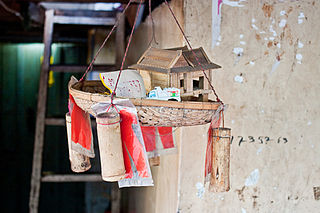
Mrenh kongveal are beings in Cambodian folk mythology resembling elves of western folklore; they are particularly associated with guarding animals. By anecdotal accounts the roots of Mrenh kongveal appear to be uniquely Khmer. The mrenh kongveal are small in stature with bodies comparable in size to human children, and are fond of mischief. Offerings are often left to them when seeking their help.
George Groslier was a French polymath who – through his work as a painter, writer, historian, archaeologist, ethnologist, architect, photographer and curator – studied, described, popularized and worked to preserve the arts, culture and history of the Khmer Empire of Cambodia. Born in Phnom Penh to a French civil servant – he was the first French child ever born in Cambodia – Groslier was taken by his mother to France at the age of two and grew up in Marseille. Aspiring to become a painter, he tried but failed to win the prestigious Prix de Rome. Shortly afterwards, he returned to Cambodia, on a mission from the Ministry of Education. There he met and befriended a number of French scholars of traditional Cambodian culture. Under their influence, he wrote and published, in France in 1913, his initial book on this subject: Danseuses Cambodgiennes – Anciennes et Modernes. It was the very first scholarly work ever published in any language on Cambodian dance. He then returned to Cambodia, traveling the length and breadth of the country to examine its ancient monuments and architecture. From this experience came his book A l'ombre d 'Angkor; notes et impressions sur les temples inconnus de l'ancien Cambodge. In June 1914, Groslier enlisted in the French army and was employed as a balloonist in the early part of World War I. It was during this time that he met and married sportswoman Suzanne Cecile Poujade; they eventually had three children.
LinDa Saphan is a Cambodian artist and social anthropologist. Born in Phnom Penh, she grew up in Canada and graduated in France. She has supported women artists from Cambodia, co-organizing the first Visual Arts Open festival celebrating Cambodian artists in 2005. Her recent art work had included textiles and embroidery. As an academic, she is currently assistant professor of sociology at Paris Nanterre University.
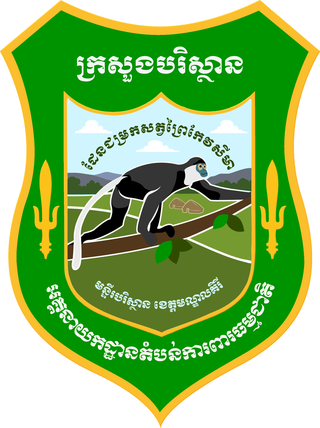
Keo Seima Wildlife Sanctuary is a 2,926.9 km2 (1,130.1 sq mi) protected area of mixed seasonal tropical forest in eastern Cambodia, located in Mondulkiri and Kratié provinces. The area was first established as Seima Biodiversity Conservation Area in 2002, later becoming Seima Protection Forest in 2009, finally becoming Keo Seima Wildlife Sanctuary in 2016. The site is of national, regional, and global importance for a range of biodiversity, with more than 950 species recorded within the protected area. It is also the ancestral and contemporary home of a large number of the Bunong ethnic group.
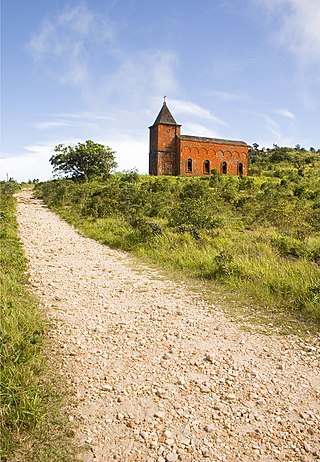
The Church of Mount Bokor also known as the Old Catholic Church of Bokor Mountain is second-oldest standing Roman Catholic church in the Kingdom of Cambodia atop the Bokor Hill station. Built in the 1920s, it is one of the few churches in Cambodia to have survived the systematic destruction of churches and pagodas under the terror of the Khmer Rouge. Currently in ruins, a restoration project is under development.
Ta Pech, Khleang Moeung or Sena Moeung is a mythical-historical sixteenth century military leader in, and a guardian spirit neak ta whose field of action extends to the entire west of Tonle Sap Lake.
Chhim Krasem or Krassem was a member of the Khmer intelligentsia during the first half of the 20th century during the period of transition from the French protectorate to the independent Kingdom of Cambodia.
Heng Vong Bunchhat is a Cambodian lawyer, who is a Senior Adviser to the Government most famous for setting up the Khmer Rouge Tribunal. He was the candidate nominated by the Royal Government of Cambodia for election to the International Criminal Court in 2003. He is considered as the father of the Constitution of Cambodia, having drafted both the republican Constitution of 1974 and the royalist Constitution of 1993.
Phnom Thnout-Phnom Pok Wildlife Sanctuary is a 42,097 ha protected area in northern Cambodia, located in Siem Reap province. The area was formally protected as a wildlife sanctuary in August 2017. The area is supported by Our Future Organization, with the conservation program developing out of the BeTreed ecotourism social enterprise first established in 2013.


